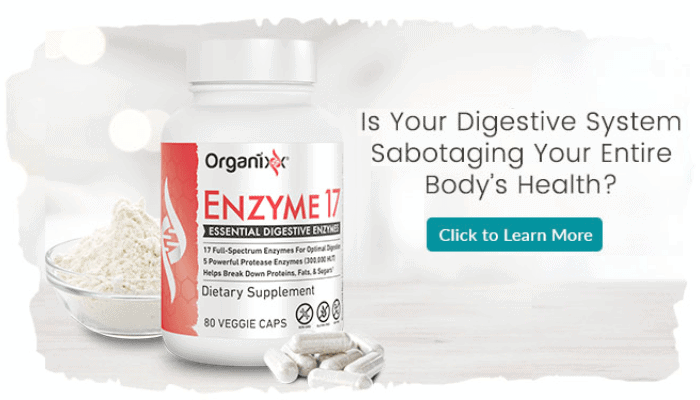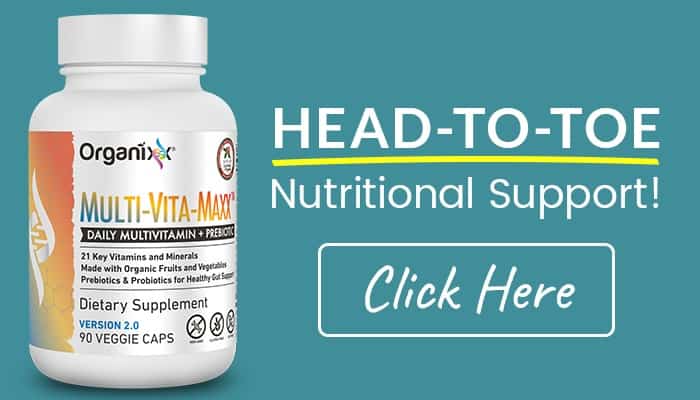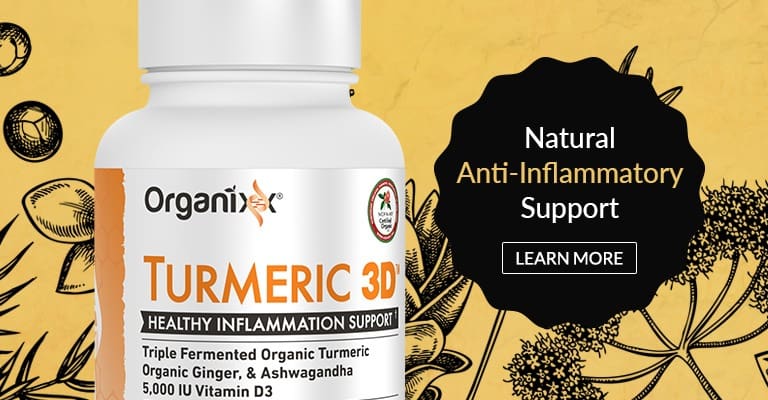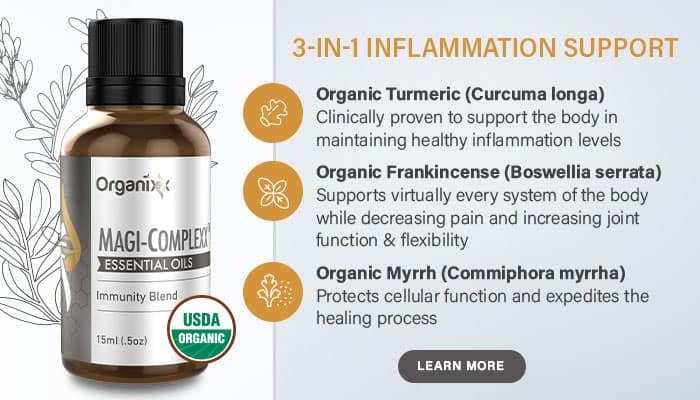Dog and cat food comes in all shapes, flavors, varieties, and formulas. But it might surprise you to learn that even high-end dog and cat food brands that you assume are “healthy” are often still missing one vital ingredient… enzymes.
In fact, much of the pet food on store shelves is lacking in at least seven unique enzyme types that are critical for healthy digestion and absorption of nutrients. Enzymes are inherently delicate and very easily damaged or destroyed by heat and other factors [1].
Enzymes are typically absent from anything that’s been cooked or processed – including most major pet food brands on the market today. This is a serious problem. Without enzymes in their diets, dogs and cats are deprived of an important energetic substance that directly contributes to [2]:
- proper nourishment
- sustained energy production
- vibrant immunity
- healthy body weight
- sturdy teeth and gums
- balanced detoxification
- strong bones and joints
All of these are vital for your four-legged friend to live a long and vivacious life.
Without Enzymes, Pet’s Bodies Are Forced to Compensate
 There are essentially two classes of enzyme that dogs and cats need for optimal health [3]:
There are essentially two classes of enzyme that dogs and cats need for optimal health [3]:
- digestive enzymes
- metabolic enzymes
The two are very similar, with the primary difference being that digestive enzymes are supposed to come from food, while metabolic enzymes are manufactured inside the body.
When animals consume what they were designed to eat (living foods that haven’t been cooked or otherwise altered), they get plenty of digestive enzymes naturally.
This allows the metabolic enzymes to perform their respective duties. Unfortunately, most pets aren’t given the raw food diets of their wild ancestors, and their bodies need to adjust to make up for the enzyme deficiency.
Metabolic enzymes can be repurposed to serve as digestive enzymes when necessary. Your pet’s body can produce a finite (limited) amount of enzymes before exhausting itself and depleting its internal stores. This is when problems like digestive dysfunction start to arise, which can eventually progress into various chronic diseases.
This grim scenario is obviously something that every pet owner wants to avoid, which is why it’s critical to take action before the situation spirals out of control. This requires either completely revamping your pet’s diet to include more raw and native foods, or actively supplementing it with digestive enzymes in order to fill the nutritional gap.
A Healthy Diet for Dogs & Cats Requires Enzymes
Not everyone has the time and budget to prepare a well-balanced raw food diet for their pet on a daily basis. Many conscious pet owners choose to enhance their pets’ existing diets with a high-quality enzyme supplement, making them more nutritionally complete.
But what, exactly, constitutes a high-quality enzyme supplement? And more specifically, which enzymes are most critical for the health of your pet?
It all starts with the four basic types of digestive enzymes: amylase, protease, lipase, and cellulose [4].
#1: Amylase, an enzyme primarily found in saliva and pancreatic fluid that’s responsible for converting starches and glycogens into simple sugars. In essence, amylase catalyzes the conversion of carbohydrates into smaller monosaccharides like glucose, fructose, and galactose that a pet’s body can actually absorb. These monosaccharides travel through the intestines into the blood and liver, where they’re transformed into a usable source of energy.
If your pet pal seems to lack energy on a regular basis, this could be a sign of an amylase deficiency. This is because carbohydrates consumed aren’t being broken down into their simplest and most usable forms for energy production. Other common symptoms of amylase deficiency include skin rashes, constipation and gas, and blood sugar problems [5], which represent many of the same symptoms associated with other enzyme deficiencies.
#2: Protease, or proteolytic enzyme, is responsible for hydrolyzing, or breaking down, the peptide bonds of food proteins in amino acids. Amino acids are the basic building blocks of proteins that a pet’s body utilizes for basically every essential biological process. Whether it’s generating new cell tissue, building muscle mass, manufacturing hormones, or balancing fat stores, amino acids are there to make it happen [6].
#3: Lipase is the enzyme responsible for breaking down lipids, which are also known as fats. In the presence of triglycerides, lipase works alongside liver bile to split fat molecules into their base components, which include fatty acids and monoglycerides: two fundamental fat compounds that function as backup sources of energy for a pet’s body, as well as fuel for the central nervous, endocrine, and cardiovascular systems [7].
#4: Cellulase is an enzyme that tackles the breakdown and assimilation of vegetable fibers and other cellular material found in plants. Like other enzymes, it converts larger, less-absorbable substances into smaller, more absorbable substances. Unlike amylase, protease, and lipase, cellulase isn’t produced inside a pet’s body at all, which means it has to be supplemented through nutrition.
You may be surprised to learn that your pet may not be getting everything they need from their food. Watch this video to learn more about the seven critical nutrients that are likely missing from your pet’s diet.
#5: Bromelain is another digestive enzyme similar to protease that helps ease the burden of breaking down proteins. Most commonly found in the flesh and stems of pineapples, bromelain has been found to support healthy inflammation levels, help relieve pain, reduce swelling, and boost wound healing [8].
A 2010 mouse study published in the journal Inflammatory Bowel Disease reported that bromelain given to mice with colitis “decreases inflammation severity and the incidence and multiplicity of inflammation-associated colonic neoplasiahas [9].”
#6: Xylanase plays a more distinct enzymatic role, breaking down a very specific type of fiber known as hemicellulose, found in vegetable and plant matter, into a simple sugar known as xylose. Xylanase works to produce more food matter for the beneficial bacteria that live inside a pet’s gut, as this collective microbiome is responsible for extracting and assimilating nutrients while further supporting the digestive process [10].
#7: Beta glucanase is actually a grouping of enzymes that, similar to amylase, is responsible for breaking down carbohydrates. It differs, however, in the fact that it targets a specific type of polysaccharide known as beta glucans that, without the presence of beta glucanase, can’t be digested naturally by your pet’s body.
Beta glucans function as a type of intestinal fiber that helps to promote regularity, balance cholesterol and blood sugar levels. They also prevent the formation of damaging bacterial growths known as “biofilms” that directly contribute to the formation of malignant yeast overgrowths like Candida albicans [11].
Why Your Pet Needs More Enzymes
When all of these powerful enzymes are joined together, they create a digestive army of synergistic crusaders that ensures every last nutrient in your pet’s food is put to good use.
This enzymatic entourage also frees up your pet’s metabolic enzymes to perform their normal functions, rather than picking up the slack of the digestive enzymes that are nowhere to be found in most store-bought kibble.
Remember: Even if the food you give your pet falls on the healthier end of the spectrum, it’s more than likely still deficient in enzymes. That’s why most pets can still benefit greatly when their food is fortified with natural, living enzymes.
Oh, and by the way… people need enzymes too!
Organixx Enzyme 17 contains a whopping FIVE kinds of powerful protease enzymes in combination with one of the most advanced enzyme blends on the planet. It’s scientifically designed to help your body break down and process nutrients for better absorption, digestion, and overall health.
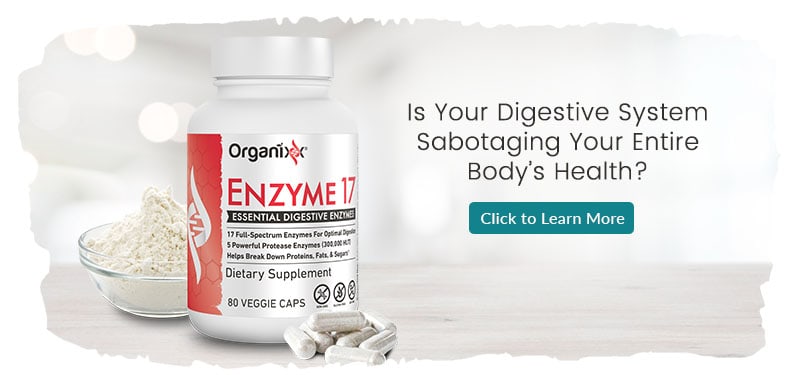
There was a time not too long ago when human beings were able to extract the majority (if not all) of the vital nutrients we needed for good health from the food we ate and our outdoor-focused, active lifestyles.
It is a sad fact that in these modern times, this is no longer the case. In fact, a 2006 study published in the Journal of the International Society of Sports Nutrition found that food alone doesn’t cut it when it comes to getting all the nutrients the body needs. Of the 70 healthy athletes analyzed by the study researchers, every one of them was deficient in at least three essential vitamins or minerals.
If top athletes (who are oftentimes obsessed with good nutrition) can become nutrient deficient… what does that say for the rest of us more than a decade later?
The 7 Most Common Nutrient Deficiencies in the World
Ironically, the nutrients we’re most deficient in are also some of the ones that are the most important for overall health. Here is a brief rundown of what they are and what they do:

#1 – Iron.
According to the World Health Organization (WHO), the most common nutrient deficiency in the world is iron deficiency as well as the number one cause of anemia in women and children.
Iron is a necessary component of hemoglobin in blood; this substance is what transports oxygen from the lungs via the circulatory system. On the other hand, studies have shown that too much iron may raise your risk of cancer and heart disease.
Experts recommend that individuals who think they may be iron deficient first consider getting a serum ferritin test. Recommended safe levels are usually between 40 and 60 ng/ml.
#2 – Vitamin E.
According to a 2009 report from the U.S. Department of Agriculture (USDA), a whopping 86% of the American population does not meet the U.S. recommended daily allowance (RDA) for vitamin E. [In perplexing contrast to this government data, diagnosed cases of vitamin E deficiency – i.e., α-tocopherol concentrations of less than 12 μmol/L (516 μg/dL) in adults – is rare.]
Vitamin E is a nutrient that is found in many foods, such as avocados, broccoli, and almonds. In the body, it acts as a powerful antioxidant and immune system booster. Vitamin E is also the “ambassador and translator” for cells, helping them to communicate effectively with one another.
#3 – Vitamin A.
Vitamin A is essential for healthy skin, teeth, bones, and vision. Most importantly, however, vitamin A helps to maintain the integrity of cellular membranes.
Beta-Carotene, the “pre-vitamin” for vitamin A, comes from fruits and vegetables as well as in quality multivitamins. In order for the conversion process from beta-Carotene to retinol (the absorbable form of vitamin A) to occur, a person needs a strong digestive tract and a healthy gallbladder.
According to data from the World Health Organization (WHO), vitamin A deficiency is the leading cause of blindness in children worldwide.
#4 – Vitamin D.
Vitamin D gets a lot of press these days linking it to breast cancer prevention. The American Association for Cancer Research (AACR) reported back in 2008 on a meta-analysis of four studies examining the link between vitamin D levels in the blood and breast cancer risk. One study found that sufficient levels of vitamin D led to a 80% reduction in breast cancer!
As reported by the AACR:
“An inverse association was observed between serum 25-hydroxyvitamin D [25(OH)D] levels and risk of female breast cancer in four recent observational studies. However, the exact 25(OH)D serum levels associated with a specific level of reduction in breast cancer incidence are still imprecise.”
Vitamin D, which is more of a hormone than a vitamin, is essential for health in other ways too – especially as a helper for other vitamins. For instance, vitamin D is intricately connected to the absorption of vitamin A, vitamin K, and calcium.
The current worldwide epidemic of vitamin D deficiency is caused in part by our modern work and lifestyle choices, which does not leave much time for enjoying the sun outdoors.
#5 – Magnesium.
The latest studies suggest that roughly 68% of all Americans are deficient in magnesium and up to 20% may suffer from severe deficiency.
The list of essential functions in the body that magnesium is responsible for is long. It includes:
- Nerve and muscle function
- Genetic synthesis
- Energy production and balancing
- Absorption of other key nutrients like iodine and vitamin C
- Hormonal health
- Sleep quality
- Protection from heavy metals like mercury and aluminum
Magnesium deficiency has been linked in studies to higher risk of cancer as well as cognitive breakdown and heart disease.
#6 – Vitamin C.
When you were a kid, you probably heard someone in your family say, “Come take your vitamin C!” whenever you had a cold. That advice wasn’t that far off. Vitamin C (ascorbic acid) is a necessary nutrient for immune system health. It is also important for the cardiovascular system since it is needed for the absorption of iron from food.
Vitamin C is also a powerful antioxidant which helps in the formation of collagen and wound healing. Surveys from the U.S. and Britain found that vitamin C deficiency occurs in 1 in 5 men and 1 in 9 women.
A 2004 report by the American Centers for Disease Control stated that vitamin C “may be the most important water-soluble antioxidant in human plasma” and that 13% of Americans are notably deficient in it.
Vitamin C must come from either food or supplementation; the body does not create vitamin C on its own.
#7 – Vitamin B12.
There are 8 B vitamins in all and all of them combined influence just about every single mechanism in the body. Getting enough vitamin B12 is especially important for the nervous system and brain health.
According to researchers at Tufts University, about 40% of adults have B12 levels below the normal range. Deficiency in this vital nutrient can lead to depression and other mental disorders, loss of the senses like taste and smell, cognitive decline, anemia, neuropathy in the hands and feet and cardiovascular issues.
Deficiencies in other B vitamins, such as B1, B2, and B6, are also quite common.
Why Are We So Deficient in Key Nutrients?
The body needs essential vitamins and minerals to complete the thousands of second-by-second functions it performs for health. Everything from maintaining good gut balance to keeping your heart pumping is reliant on the efficient break-down and use of nutrients.
“I eat a healthy diet,” you may be thinking, “so I have nothing to worry about, right?”
There was a time when this was true, but no longer. Even if you are someone who eats healthy, organic food every day, you can still have nutrient deficiencies.
First of all, because of poor soil, contaminants in the air and water, and an increasingly genetically modified food supply, the nutrient load of most produce is significantly less than it used to be.
A report published in 2004 by the University of Texas studied the nutritional value of 40 common fruits and vegetables grown in the U.S. between 1950 and 1999. What they found was shocking.
Over those 40 years, all of the foods they studied had “reliable declines” in key nutrients, including calcium, iron, vitamin C, and B vitamins.
The second reason has to do with malabsorption of nutrients within the body itself. Even if you are consuming great quantities of key essential nutrients, your body may not be able to absorb them properly in order to put them to work in your body.
The Most Common Causes of Nutrient Malabsorption
- Genetic dispositions (and environmental triggers that kick them into gear)
- Issues with methylation
- Issues with detoxification pathways
- Imbalances within the digestive tract itself
- A combination of these factors and others
All of these factors, including the expression of your genes, are influenced by one thing: lifestyle.
Diet, stress level, exercise level, hydration levels, and the quality of any supplements you are taking all play a part in malabsorption.
The last factor – gut imbalances largely caused by eating a SAD diet (standard American Diet) – are probably the most common reason why nutrient malabsorption occurs.
11 Signs You May Have a Nutrient Deficiency
 Nutritional deficiency tests, including blood, saliva, and urine tests, can be very beneficial in letting you know if you are low in a particular vitamin or mineral.
Nutritional deficiency tests, including blood, saliva, and urine tests, can be very beneficial in letting you know if you are low in a particular vitamin or mineral.
But before you ever send anything to the lab, sometimes you can determine if you have a dietary deficiency by watching for nutrient deficiency symptoms and signs in your own body.
Do You Have Any “Red Flags” for Nutrient Deficiencies?
According to functional nutritionist and best-selling author Dr. David Jockers as well as other experts, the following symptoms may be “red flags” for nutritional deficiencies:
- Hair loss
- Discoloration or ridges on nails
- Dark circles under the eyes
- Skin rash or acne that persists
- Periodontal disease
- Sores on the mouth
- Tingling or other sensations in the extremities
- Brain fog and other cognitive dysfunction, such as memory loss
- Loss of sexual drive/ libido
- Depression and/or lethargy
- Ongoing fatigue
If You Decide to Supplement, Choose Only the Best
Once you’ve determined you have a nutrient deficiency, the likely next step is supplementation. When deciding on a supplement manufacturer, be aware that many companies still use synthetic ingredients and chemical additives to keep costs (and quality) down.
In fact, it is estimated that up to 95% of all vitamin and mineral supplements out there are at least partially created using synthetic materials!
The happy news is that consumer demand is growing for quality products which utilize the very latest in natural health technology.
If you decide that supplementation in one or more key nutrients is right for you, be sure to do your homework. Choose a whole food brand that is organic and tests their products regularly for toxins including heavy metals and pesticides such as Organixx Multi-Vita-Maxx.
If you’re not getting all the nutrients and antioxidants you need from food, your best source is whole food vitamins. Organixx Multi-Vita-Maxx contains 21 uniquely fermented vitamins and enzyme-activated minerals that are more “bioavailable” and easily absorbed by your body than the synthetic compounds found in most supplements.
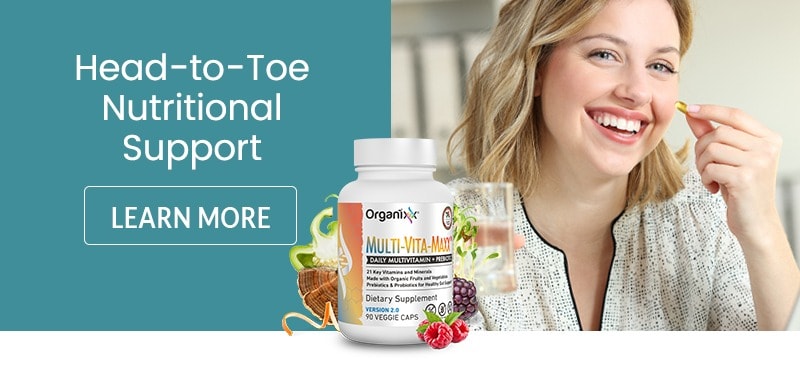
Inflammation is a popular buzzword, but not many people really understand what it means. For instance, did you know that inflammation exists to protect your body from foreign invaders, infections, and illnesses so that damaged and infected cells in your body can heal [1,2]?
In the short term, your body’s inflammatory response is vital for your health. However, it’s only meant to last a short time. When it goes on for too long – known as “chronic” inflammation – it begins to cause serious health problems [3,4].
Unfortunately, our Western medical system mainly tries to treat inflammation by using drugs to suppress the immune system, which only reduces the extent of inflammation instead of eliminating it. Such solutions don’t address the underlying issues that created the initial inflammation, which continues to take place and damage the body.
Steps to Lower Your Risk of Inflammation
You may be wondering if there is anything you can do to lower your risk of inflammation.
Promisingly, modification of diet and lifestyle habits has been shown to be very effective in minimizing inflammation in the body.
Before getting into some specific foods that can have a big impact on reducing inflammation, let’s first take a quick look at how inflammation damages the body…
Free Radicals and the Antioxidants That Neutralize Them
Free radicals, such as reactive oxygen species (ROS) and reactive nitrogen species (RNS), are constantly being produced in the body. These free radicals are responsible for the damage to our body’s cells caused by chronic inflammation [5,6].
When we’re exposed to radiation, cigarette smoke, and other pollutants, free radicals are made in our body at much higher levels than normal. This leads to a condition known as oxidative stress, which damages vital cellular structures in the body and contributes to many health problems [7,8].
What Are Antioxidants?
Antioxidants are naturally occurring compounds that protect against the damage caused by free radicals by preventing them from being formed, making them inactive, or causing their breakdown once they are made.
Fortunately for us, our body contains “innate” enzymatic antioxidant systems which break down and remove free radicals from our body [9]. However, given that we are routinely exposed to more free radicals than our body’s innate systems can handle, we need to consume antioxidants either in our diet or as supplements.
There are literally thousands of such antioxidant molecules that exist in the plant world. Antioxidants include [10]:
- vitamin A
- vitamin C
- vitamin E
- colorful plant pigments known as bioflavonoids
- green tea polyphenols
- carotenes
- anthocyanins
- allicin in garlic
- piperine in black pepper
- curcumin in turmeric
Consuming fresh, locally grown, non-irradiated, non-GMO foods that are naturally antioxidant-rich is a simple yet effective way to manage your risk of developing inflammation.
Scientific evidence shows that consuming such foods can benefit your health, reduce your risk of various age-related health conditions, and potentially even extend your lifespan.
Let’s take a closer look at five antioxidant-laden foods that are proven to be powerfully effective in countering the actions of harmful free radicals and fighting chronic inflammation.
5 Foods That Fight Inflammation
#1: Turmeric
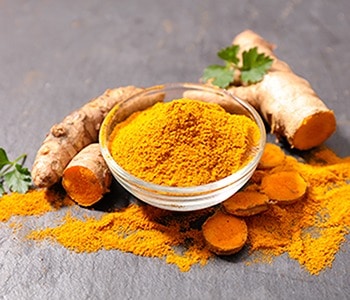 Turmeric, an integral part of the ancient medical system of Ayurveda, has been used to manage inflammation and its consequences for nearly 4,000 years [11].
Turmeric, an integral part of the ancient medical system of Ayurveda, has been used to manage inflammation and its consequences for nearly 4,000 years [11].
Modern science tells us that turmeric contains at least 100 chemical components. The main component is a volatile oil known as aromatic turmerone, or ar-turmerone, which is responsible for turmeric’s aroma [12].
Researchers are now investigating if and how ar-turmerone can help lower inflammation in brain cells, reverse memory loss, and limit brain damage by interacting with the immune system [13].
Turmeric also contains the active ingredient curcumin [14]. Thousands of scientific studies and over 100 clinical trials have shown that curcumin has remarkable antioxidant activity and neutralizes free radicals effectively. Curcumin also interacts directly with multiple targets in the body’s cells related to inflammation [15-21].
For instance, curcumin blocks production of a type of free radical known as reactive oxygen species (ROS), which plays an important role in inflammation [22].
In animal studies, curcumin has also been shown to reduce the levels of the inflammatory marker C-reactive protein (CRP) [23].
Research shows that there’s a connection between chronic inflammation and many chronic health conditions including cancer, diabetes, cardiovascular, neurological, inflammatory bowel disease, and pulmonary diseases.
According to a 2015 report published in the journal Molecules, “the antioxidant properties of curcumin can play a key role in the prevention and treatment of chronic inflammation diseases [24].”
In a study dating back to 1980 published in the Indian Journal of Medical Research, individuals suffering from joint-related problems who consumed curcumin supplements reported significant improvements in morning stiffness, walking time, and swelling [25].
Metabolic syndrome is a health condition in which inflammation plays a role and whose symptoms include high blood pressure, excess blood sugar, and poor weight management. If left unchecked, it can lead to potentially deadly health problems. In a double-blind, placebo-controlled study reported in the journal Nutrition in 2016, individuals with metabolic syndrome were given either curcumin or placebo for eight weeks [26].
Individuals who consumed curcumin showed improved blood levels of multiple inflammation markers, including CRP. They also had lower blood sugar levels. In conclusion, the study’s senior author stated that, “The findings of our studies, along with clinical findings reported by other groups, indicate the usefulness of daily use of curcumin supplement for the prevention and treatment of several diseases [27].”
Curcumin also helps to manage the effects of chronic inflammation on the skin. Radiation therapy causes many severe side effects, including radiation dermatitis caused by local inflammation. In a randomized, double-blind, placebo-controlled clinical study, patients were given either two grams of curcumin or control orally three times daily throughout their radiation therapy sessions [28]. Curcumin therapy was shown to significantly reduce the severity of radiation dermatitis.
Similarly, both turmeric and curcumin have been shown to help manage other skin conditions associated with inflammation.
#2: Foods Containing Omega-3 Fatty Acids
Omega-3 fatty acids are also known as essential fatty acids because they are essential for many important biological processes in the body. However, our body cannot make them, so we need to get them from our diet or from supplements. Alpha-linolenic acid (ALA), eicosapentanoic acid (EPA), and docosahexanoic acid (DHA) are the best-known omega-3 fatty acids [29,30].
Good sources of ALA include chia seeds, flax seeds, hemp seeds, walnuts, almonds, and hazelnuts. DHA and EPA are present in cold water fatty fish such as mackerel, sardines, salmon, herring, and trout, and in fish and krill oils.
In fact, DHA and EPA are originally made by microalgae – and when krill and fish consume these algae, they accumulate DHA and EPA in their bodies [31,32]. The only practical way for us to get the levels of EPA and DHA we need to maintain our health is to get them directly from foods and supplements.
Omega-3 fatty acids are important structural components of the so-called “cell membranes” that surround and protect each cell in our body. Omega-3 fatty acids are also used to make signaling molecules known as eicosanoids, which carry out many functions in our heart, blood vessels, lungs, and immune and hormonal systems [33,34]. Eicosanoids are also key mediators and regulators of inflammation.
Arachidonic acid is our body’s main source of pro-inflammatory eicosanoids. EPA and DHA compete with arachidonic acid in making eicosanoids. Higher levels of EPA and DHA have been shown to tip the balance in our body toward lower inflammatory activity [35].
For instance, animal studies show that production of arachidonic acid‐derived eicosanoids can be reduced by EPA or DHA consumption [36]. Similarly, numerous studies with both healthy human volunteers and patients with inflammation-related health conditions show that consuming fish supplements containing EPA and DHA can lower production of arachidonic acid‐derived eicosanoids in their body [37].
EPA and DHA also help to manage inflammation by lowering production of the small immune signaling proteins known as cytokines, reducing the activity of immune T cells, and blocking production of the pro-inflammatory transcription factor NF-kappa B [38].
#3: Medicinal Mushrooms
 Did you know that more than 100 mushroom species are currently being studied all over the world to uncover their health benefits? Modern scientific research is now confirming what many ancient cultures have long known – that mushrooms contain some of the most potent, yet safest chemical ingredients found in nature [39].
Did you know that more than 100 mushroom species are currently being studied all over the world to uncover their health benefits? Modern scientific research is now confirming what many ancient cultures have long known – that mushrooms contain some of the most potent, yet safest chemical ingredients found in nature [39].
One such medicinal mushroom is Chaga, which has long been part of traditional folk therapy in Russia and other northern European countries. This mushroom contains many potent compounds and is known to have antioxidant properties [40-42].
For instance, a 2016 study showed that a Chaga polysaccharide could neutralize free radicals [43]. Another 2012 study showed that a water-based extract of Chaga could reduce the expression of pro-inflammatory cytokines [44].
Reishi is another well-known medicinal mushroom. Used for over 2,000 years by sages and shamans for traditional medicinal purposes, Reishi is well known for being able to both relax and fortify mind and body [45,46].
Natural chemicals present in Reishi have been shown to have antioxidant and immune-strengthening properties [47, 48]. For instance, a Reishi extract has been shown to neutralize free radical activity and support healthy liver function [49]. Health experts also believe that Reishi can help to counter some of the symptoms of aging, thanks to its anti-inflammatory properties, ability to fight free radicals, and reduce cellular damage associated with oxidative stress [50-52].
Cordyceps, also known as the caterpillar fungus, has long been a part of traditional Chinese and Tibetan medicine [53-55]. The authors of a 2012 study stated that Cordyceps polysaccharides “can also improve the antioxidation activity in immunosuppressed mice, significantly increase the superoxidase dismutase, catalase, and glutathione peroxidase levels and the total antioxidant capacity, and decrease the malondialdehyde levels in vivo [56].”
In fact, superoxidase dismutase, catalase, and glutathione peroxidase are innate enzymatic antioxidant systems in our body, while malondialdehyde is used as a marker for free radical damage. In other words, cordyceps directly helps to neutralize free radicals and also helps boost our body’s natural antioxidant systems.
#4: Green Tea
Tea is the most popular beverage consumed worldwide after water. Popular in Japan and parts of China, green tea accounts for about 20% of total tea production and has been thoroughly studied for its health benefits. Green tea contains caffeine, tea polyphenols, chlorophyll, and other compounds that contribute to its aroma and taste.
Green tea polyphenols include the catechins, of which epigallocatechin-3-gallate (EGCG) and epigallocatechin (ECG) possess antioxidant activity and have been shown to have anti-inflammatory effects in multiple laboratory, animal, and human studies [57-61].
Specifically, green tea and ECG have been shown to suppress the expression of pro-inflammatory cytokines and inflammation-related enzymes, along with blocking the activity of the pro-inflammatory transcription factor NF kappa B.
In other words, green tea extracts and tea polyphenols may prove to be useful in alleviating health conditions in which chronic inflammation plays a role [62,63].
#5: Wild Blueberries
Blueberries, native to North America, are closely related to cranberries, bilberries, and huckleberries. They contain polyphenolic compounds known as anthocyanins, which are water-soluble pigments that can appear red, purple, or blue, depending on their pH.
More than 600 anthocyanins have been identified in nature, where they mainly act as antioxidants to counter the actions of free radicals formed as a result of overexposure to UV light and extreme temperatures [64].
Laboratory studies as well as human clinical trials indicate that both blueberries and the anthocyanins they contain possess significant anti-inflammatory properties [65]. For instance, in a 2013 study published in the European Journal of Nutrition, consumption of a drink made from wild blueberries significantly reduced levels of oxidized DNA and increased resistance to oxidatively induced DNA damage in healthy male volunteers [66].
All the available evidence suggests that the anti-inflammatory actions of blueberries are linked to their antioxidant properties [67].
There you have it, 5 foods that are readily accessible in either whole food form or supplements that aid the body in minimizing the damaging effects of inflammation naturally: turmeric, omega-3s, medicinal mushrooms, green tea, and blueberries.
Replacing the processed, pro-inflammatory foods in your diet with these foods and beverages that are high in antioxidants is a positive step in reducing inflammation itself, as well as the debilitating diseases linked to chronic inflammation.
Turmeric 3D from Organixx provides you one of the most “bioavailable” forms of turmeric due to its unique fermentation process. This means your body experiences the maximum benefits of the purest, most potent turmeric available!
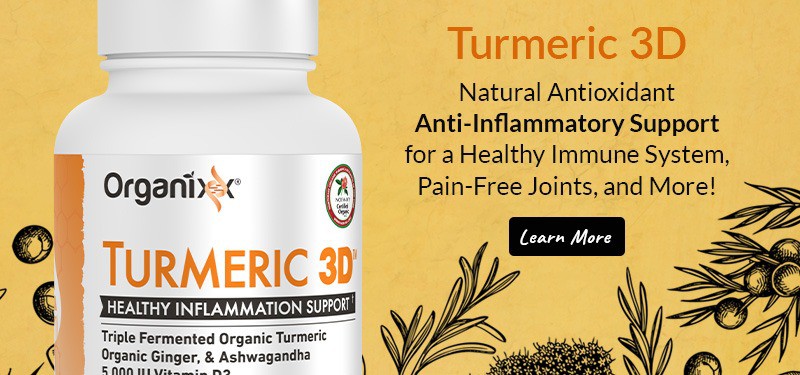
Most people don’t give filling up their pet’s water bowl much thought. But experts agree… if you wouldn’t drink the water, then your dog or cat (or pet bunny or hamster) shouldn’t either. Most municipal water supplies (i.e. water that comes directly out of the faucet) should be filtered before being consumed. Remember Flint, Michigan back in 2011? [1] That’s just the tip of the iceberg when it comes to water quality concerns.
Here is the latest on tap water quality issues as well as 5 tips to keep your furry friend hydrated… and healthy!
Some Info About Tap Water Safety
According to a comprehensive report [2] put out by alternative media outlet News21 (a project of the Carnegie-Knight Initiative on the Future of Journalism), a whopping 63 million people in the United States were exposed to unsafe water more than once over the last 10 years.
The survey investigated municipal water supplies, from rural neighborhoods to major metropolitan centers across the country.
Six decades of consumer dumping, farm pollution, industrial waste, pipe deterioration, and cutting corners have taken their toll. What’s more, journalists found that the average time it took municipalities of all sizes to fix known and hazardous drinking water pollution issues was roughly two years.
Especially slow to remedy water issues are smaller, low income municipalities who simply do not have the resources to fix the problem.
Pollution in tap water supplies is responsible for gastro-intestinal disorders, hormonal imbalances, neurological conditions (such as those caused by fluoride and chlorine), and a host of other disease conditions, including cancer [3].
The question for you as a pet owner is: If 63 million humans were exposed to polluted water and its side effects over the last 10 years, how many four-legged family members were affected as well? And at what cost?
5 Water Quality Tips for Pets (hint: they’re good for humans too!)
The quality of your pet’s drinking water truly has an impact on their health and well-being, as it does yours. Check out these five tips to get (and keep) them hydrated and healthy:
#1. Check your municipal water supply.
Get the low-down about your pet’s drinking water supply. Your local plant is federally regulated, but your state, county, city, or town may have their own rules regarding safety and treatment. Each plant is also required to publish a yearly “consumer confidence” report and, as a resident, you have the right to see it.

Give your local government agency a call to get a copy. Then check out which chemicals are being used to treat the water at the plant as well as what kinds of toxins may legally be added as it makes its way from the plant to you.
#2. Check the water in your home.
Next, gather information about the state of the water that comes directly out of your tap. The plant’s water quality may be vastly different from what makes it to your pet.
Old pipes, distance traveled, and other factors all can play a part in water quality. You can get a breakdown of what is in your and your pet’s water by purchasing a home water test kit or obtaining a free kit (if available) from your local water municipality.
The U.S. Environmental Protection Agency suggests sending your sample to a certified lab. You can call the EPA’s Safe Drinking Hotline at (800) 426-4791 for more information on how to do this [4]. Your local government office may have information about certified labs as well.
#3. Get a quality water filter for your home.
Odds are, after you see what is lurking in your drinking water, you will want to get a filter for your home. What kind is best for your whole family, including the four-legged members?
Consumer Reports states that the best filters are those which cater to your individual household’s needs. Most filters, even carafe-types, will filter out lead and chloroform. However, you may need a more advanced system, such as reverse osmosis, if your water supply contains fluoride, uranium, or other hard-to-remove toxins and pathogens.
Consumer Reports [5] suggests you make sure that your filter is labeled “NSF certified” for the particular substances you want removed. NSF stands for National Sanitation Foundation. It is the most recognized product testing and inspection organization in the United States and was founded in 1944 through the University of Michigan’s School of Public Health [6].
#4. Don’t use bottled water.
Bottled water is bad for the environment, bad for you, and bad for your pets. BPA, or Bisphenol A, is one of the nastiest toxins and it is present in abundance in most plastic water bottles.
BPA, or Bisphenol A, is one of the nastiest toxins and it is present in abundance in most plastic water bottles.
BPA is a known endocrine disruptor that can wreak havoc on mammalian hormone levels and cause hormone-related cancers [7].
A 2008 University of Cincinnati study [8] found that the temperatures to which the plastic is exposed makes much more of a difference than previously suspected. In fact, it may be the main factor in determining how much a chemical leeches into the water inside the bottle.
You may not put your water bottles in the sun or in a hot room, but who knows what conditions those bottles have been exposed to at the warehouse and en route to your grocery store. Say no to plastic water bottles – period!
#5. Stay away from hard water.
In addition to the chemicals found in tap water, it is also important to keep your pet away from long-term use of hard water. Water is “hard” when it has high levels of common minerals – usually magnesium and calcium.
According to a recent study conducted by the pet insurance company Trupanion [9], the presence of these minerals in your pet’s drinking water may lead to urinary issues such as urinary tract infections, cystitis, incontinence, and crystalluria in both cats and dogs.
The EPA defines “water hardness” as 64.8 milligrams of calcium carbonate to 1 U.S. gallon of water.
The safety of your pet’s drinking water is easy to determine. If it is harmful to people, then it is harmful to pets, plain and simple. Give your pet the best chance for a healthy, vital, and long life. Be sure there is plenty of pure, filtered water in his or her bowl!
Bonus tip:
Don’t feed your pets or give them water in plastic bowls which can leach harmful toxins. Glass, ceramic, or stainless steel are much healthier/safer options.
Organixx Cleanse & Detoxx is a two-step formula that provides a gentle yet powerful full-body detox using organic botanical ingredients. Naturally purge your body of toxins, chemicals, free radicals, heavy metals, waste, as well as bacteria, and pesticides. Easily cleanse your colon, liver, kidneys, lungs, and lymphatic system resulting in increased energy, and better digestion with more nutrient absorption, in addition to improved immunity, mental clarity, and overall health and wellbeing.
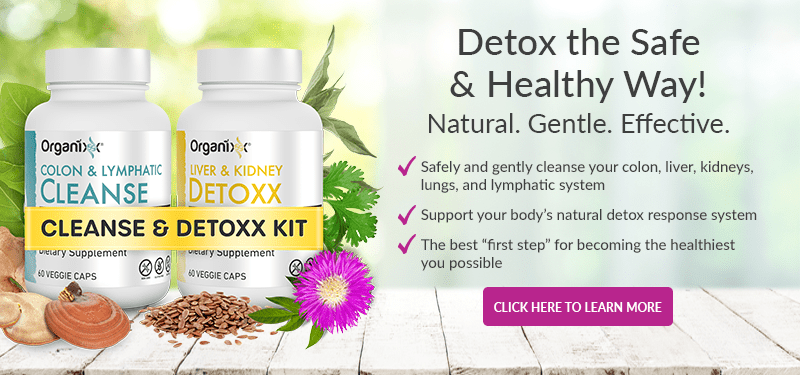
If you have pets in your home, chances are the air doesn’t always smell as “fresh” or “pretty” as you like it. This idea is reinforced when we see TV advertisements of home owners gleefully spraying air freshener on and around couches, dog beds, and cat litter boxes. Or happily plugging air fresheners into wall sockets. But if you want your pets to stay healthy and toxin-free, they need to stay away from commercial air fresheners at all costs… and you should too!
The fragrance molecules that make up chemical plug-in air fresheners like the popular brands sold in grocery stores are called volatile organic compounds (VOCs). The chemicals used in these products are anything but organic, however.
Fortunately, there are some natural, non-toxic alternatives that you can use without the risk of sending Fido or Fifi to the vet. With some knowledge and a little caution, you can have a fresh-smelling home and healthy pets too!
Why Are Air Fresheners Toxic?
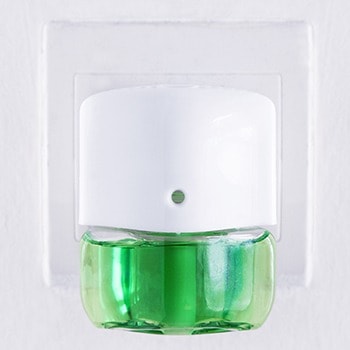 If you are a parent, then you probably recall all the precautions you took to keep harmful chemical substances away from your baby and toddler. Pet parents have that same responsibility. The big difference, however, is that keeping your fur babies protected from harm lasts a lifetime!
If you are a parent, then you probably recall all the precautions you took to keep harmful chemical substances away from your baby and toddler. Pet parents have that same responsibility. The big difference, however, is that keeping your fur babies protected from harm lasts a lifetime!
These precautions are especially important when it comes to commercial air fresheners, scented candles, and potpourris – all of which contain some of the most hazardous chemicals out there today.
Amongst the hundreds of fragrance-related chemicals that are either known carcinogens or have yet to even be tested for their safety, here are three of the most common:
#1 – Benzene. Benzene is one of the most abundant chemicals found in fragrance products. It is derived from petroleum and has been linked to cancer, especially leukemia [1].
#2 – Formaldehyde. Formaldehyde is another scent chemical with associations to respiratory issues, nasal cancer, and leukemia [2]. Despite its use in air fresheners and other “smelly” products, it is often odorless and colorless.
#3 – Phthalates. Next on the list are the many categories of “phthalates.” These include Di-n-butyl Phthalate (DBP), Diethyl Phthalate (DEP), Dimethyl Phthalate (DMP), Diisobutyl Phthalate (DIBP), Dimethyl Phthalate (DMP) and Diisohexyl Phthalate (DIHP). All of these substances can cause reproductive changes, hormone imbalance and, in some cases, cancer. Di-n-butyl Phthalate (DBP) is recognized by the National Toxicology Program and by the state of California as a ”reproductive toxicant [3].”
What About Using an Air Purifier Along With Air Fresheners?
Some pet parents (and people parents) may think that commercial air fresheners are safe as long as they are used in conjunction with an air purifier. This is not the case, however.
A University of California-Berkeley study found that using an air freshener in a room along with an ozone-producing air purifier still resulted in formaldehyde levels that were 25% higher than California state recommendations [4].
Essential Oil Diffusers and Pets
 One viable alternative to harsh chemical air fresheners is essential oil diffusers and using organic essential oils. Keep in mind, however, that your furry family members have more sensitive bodies – and especially more sensitive sniffers – than you do!
One viable alternative to harsh chemical air fresheners is essential oil diffusers and using organic essential oils. Keep in mind, however, that your furry family members have more sensitive bodies – and especially more sensitive sniffers – than you do!
Take precautions by following these 5 “Essential” tips:
#1 – Take it slow with new scents.
Your pet’s sense of smell is their most valuable, and precious, asset. A dog’s sniffer is 100,000 times more powerful than a human’s [5]!
A cat’s sense of smell is a little bit less acute, but still very strong. This means that your pets are super sensitive to every little smell that may be lingering in your home. Take it slow when introducing a new diffuser oil. A good way to do this is to wear the essential oil on yourself first and see how your pet reacts.
#2 – Choose the right kind of diffuser.
Passive diffusers evaporate essential oils, sometimes in a carrier oil or soy candle, to produce a pleasant fragrance. Active essential oil diffusers such as nebulizers and ultrasonic diffusers use pressure to create fragrant droplets that float in the air.
If you have an allergy-prone pet, you may consider sticking to a passive diffuser. As a side note, most veterinary experts do not recommend diffuser use around birds.
#3 – Choose a safe place to put your diffuser.
As you know, your pets are curious creatures. Anything new within close vicinity may be a target for batting, chewing, or extra sniffing. Ideally, you want to put your diffuser in a room that is not usually occupied by your pet.
This can be a tall order if you have an active animal in your home, however. At the very least, make sure your diffuser is located in an area of your home where your dog or cat cannot access it easily.
#4 – Check for reactions.
After you introduce a diffuser in a room and for a little bit afterwards, take note of any unusual behavior or side effects. Sneezing, coughing, vomiting, and lethargy may be telltale signs that something is not right. If this happens, immediately remove your pet from the area. Ideally, take him or her outside to get some fresh air. If side effects continue or get worse, contact your veterinarian right away.
#5 – Keep essential oil diffusers away from cats.
Cats have more restrictions than dogs when it comes to essential oils. While opinions differ on the subject even amongst experts (some say peppermint oil can be handled in small amounts as can cedarwood, rosemary, and lemongrass), there are some experts who caution against using a diffuser around cats at all [6].
This is because cats have thin skin, they lick their coats for cleanliness, and their livers are more sensitive than other animals.
For sure, citrus oils like lemon and orange as well as oils that contain polyphenolic compounds, such as cinnamon and oregano, should be kept away from cats at all costs [7]. Also note that both dogs and cats may have ill effects when exposed to too much tea tree (aka melaleuca) oil [8].
Lavender Essential Oil: Safe and Beneficial for Dogs
One essential oil that appears to be safe and even beneficial for dogs when used in moderation is lavender [9]. Lavender contains linalool and linalyl acetate, the terpenes most responsible for calming the nervous systems of mammals.
In fact, 100% organic, sustainably-sourced lavender essential oil may be a great scent for both you and your dog. Many of us are prone to minor anxiety or nervousness throughout the day, or simply need a wind-down scent in the evening. This calming herb is also considered to have anti-inflammatory and anti-bacterial properties for both you and your dog.
Just like with any oils, however, be sure to proceed with caution and make sure your pet does not have a sensitivity to this otherwise gentle and very calming oil.
Beware of So-Called “Green” Air Fresheners
You may have seen air freshening products that are labeled “unscented,” “all natural,” or “green.” This can be misleading, however. Many of these “natural” products also contain some of the same chemicals as regular ones. This is especially true of phthalates.
The Natural Resources Defense Council completed a comprehensive review of common household air fresheners in 2007. They found that 12 out of 14 of the most popular brands contained harmful phthalates, including many labeled in some way as “natural [10].”
The best course of action when it comes to freshening your home is to keep it clean, vacuumed, scrubbed, and exposed to fresh outdoor air as much as possible. Using ingredients such as vinegar, baking soda, and lemon to clean is also a healthy idea for all family members.
If you use organic essential oils, proceed with caution when it comes to the safety and health of your pet friends. Be sure to keep diffusers away from cats and birds, and always give your canine companion the option of leaving the room if they react to or simply do not like the smell.
And remember: do your best to never expose them (or you) to the dangerous chemicals found in commercial air fresheners in your home or vehicle!
The powerhouse trio of herbs in Magi-Complexx Essential Oil provides the strongest, most synergistic healing effect, helping sufferers of arthritis pain, constant muscle aches and pains, neuropathy, systemic inflammation, slowed wound healing, circulatory challenges, as well as skin irritations like eczema, psoriasis, and acne.

If you keep up with health news, you’re probably familiar with the buzzword inflammation and the ongoing discussion about the potentially harmful direct and side effects it can have on our health.
In fact, some health experts such as Dr. William Joel Meggs – an inflammation specialist at the Brody School of Medicine at East Carolina University and the author of the book The Inflammation Cure – even make the bold claim that inflammation ”may well turn out to be the elusive holy grail of medicine, the single phenomenon that holds the key to sickness and health.”
What Is Inflammation?
Before we try to understand why inflammation is so important and how it affects our health, let’s first consider the simple but very important question: what exactly is inflammation?
Simply put, inflammation is an important and necessary part of the healing process (i.e., our natural immune response). Its job is to protect our body against harm by:
- defending it against foreign invaders
- fighting off infections and illnesses
- repairing damaged cells and tissues in our body after injury
Normally, our immune system triggers inflammation when it recognizes anything that is alien in our body.
Such triggers can include invading bacteria or viruses, cigarette smoke, plant pollen, and the many thousands of synthetic chemicals we are exposed to during our lifetimes.
Inflammation Is the Body’s Response to Injury
We’ve all experienced inflammation when we develop a fever, bruise our knee, or cut our finger. For instance, our body reacts in a very predictable way when we twist an ankle:
- Blood flow to the affected area increases, which is why it typically turns red.
- Fluids and proteins from blood enter the injured tissues, which can cause localized swelling.
- Finally, our immune system sends a small army of white blood cells to the rescue. These typically include neutrophils, which are usually the first to travel to the site of an infection or injury. Neutrophils can literally swallow damaged cells and foreign invaders and also release enzymes that kill them.
Neutrophils may be accompanied by macrophages, another type of white blood cell that engulfs and “eats” anything not seen as healthy or normal.
In other words, short term or “acute” inflammation is a necessary, health-preserving component of our immune system’s response to injuries and infections. Without it, injuries could linger on and harm us, while even minor infections could turn deadly.
However, the key to the inflammatory process is that it is only meant to last a short time. Once our body has dealt with and gotten rid of the initial trigger or cause, the process of healing and repair should ideally begin.
What Is Chronic Inflammation?
Unfortunately, when our body’s inflammatory response goes on for too long or spirals out of control – known as chronic inflammation – it can lead to many adverse health conditions, according to health experts.
Chronic inflammation can happen when our immune system sometimes sends an inflammatory response to a perceived threat that doesn’t really exist.
At other times, the threat may be real but goes on for so long that our body’s inflammatory response also persists for a long time.
Persistent, uncontrolled inflammation – which has been linked to external factors we’ll discuss below – is damaging because it acts like a slow-burning fire, continuing to send out immune cells that eventually begin to attack healthy cells and tissues in our body.
According to Dr. Andrew Luster, of the Center for Immunology and Inflammatory Diseases at Harvard-affiliated Massachusetts General Hospital,
“It’s a smoldering process that injures your tissues, joints, and blood vessels, and you often do not notice it until significant damage is done.”
The Role of Free Radicals
Harmful free radicals, including reactive oxygen species (ROS), are believed to be the underlying cause of the damage to healthy cells caused by chronic inflammation.
Not only that, scientific research suggests that certain free radicals can directly initiate or even amplify inflammation by turning on several different genes that are involved in triggering and maintaining the inflammatory response.
These free radicals, including ROS, are likely created by the actions of the various immune cells that have been activated by the inflammatory process, specifically by the chemicals and enzymes they release into our body’s damaged tissues.
What is Chronic Inflammation Responsible for?
Chronic inflammation is now known to cause the buildup of plaque in arteries known as atherosclerosis. Our body sees such plaques as abnormal, so it tries to wall them off from flowing blood. But when that wall breaks down – and it eventually does – the plaque can rupture.
The plaque’s contents then mingle with blood, forming a clot that can block blood flow downstream where the blood vessel becomes narrower. These clots are responsible for most of the deadly heart-related health conditions (e.g., heart attack) that affect many people today.
Similarly, the more visceral fat cells we have – this is the kind of fat that builds up in the abdomen and wraps itself around organs – the more likely it is that our immune system sees them as a threat and triggers inflammation. As a result, more white blood cells enter our blood looking for a fight.
In other words, the longer we stay overweight or obese, the longer our body remains in a state of constant inflammation. According to Dr. Luster:
“This reaction is not confined to one particular place either. Inflammation can travel throughout the body and cause problems all over.”
Chronic inflammation is now believed to also contribute to the development of clinical depression and anxiety, generalized body pain, gut health disorders, and abnormal levels of tiredness or fatigue.
So, the question is: what triggers chronic inflammation and how can we manage these risks to reduce or even completely avoid our chances of developing an inflammatory condition?
What Causes Inflammation? Top 10 Offenders
Here are the top ten worst offenders believed to cause or contribute to chronic inflammation:

#1. Foods with a high glycemic index (GI) and added sugar
These include processed and refined foods such as white flour, instant mashed potatoes, and polished white rice, sweetened foods such as cakes, cookies, and muffins, and many commercially available breakfast cereals, breads, and pasta sauces.
The glycemic index (GI) is a ranking of carbohydrates on a scale from 0 to 100 according to the extent to which they raise our blood sugar levels after consumption. High GI foods are rapidly digested, absorbed, and metabolized by our body and cause significant fluctuations in our blood sugar levels.
Low GI carbs produce smaller fluctuations in our blood glucose and insulin levels; and according to many health experts, they represent one of the secrets to long-term health.
A 2002 study showed that processed sugars and high GI foods increase inflammation levels, leading to a greater risk of developing other health disorders. On the other hand, consumption of whole grains has been shown to reduce levels of the inflammation markers C-reactive protein and plasminogen activator inhibitor type 1.
High GI foods and excess dietary sugar likely trigger inflammation because they increase levels of chemical compounds in our body known as advanced glycation end products (AGEs), along with raising our risk of developing insulin resistance and harmful changes in lipid metabolism.
Scientific evidence shows that AGEs trigger inflammation in multiple ways. AGEs have also been shown to interfere with our body’s natural antioxidant defense systems and may even contribute to organ damage, compromising our health.
#2: Trans fats
A small amount of trans fats occurs naturally in certain animal foods. However, most of them are synthetically made in an industrial process that uses high pressure and chemicals to add hydrogen to liquid vegetable oils to make them more solid and have a longer shelf life.
The resulting end products, known as “partially hydrogenated oils,” are difficult for our body to process and end up triggering inflammation, at least partly by damaging cells in the lining of our blood vessels.
In 2013, the U.S. Food and Drug Administration (FDA) determined that partially hydrogenated oils are no longer Generally Recognized as Safe (GRAS) in human food. Indeed, consumption of trans fats in 823 generally healthy women in the Nurses’ Health Study I and II was seen to raise their levels of markers of systemic inflammation.
In other words, consumption of foods and food-related products containing trans fats should be completely avoided, as they have been shown to harm our health.
#3: Saturated animal fats
Consumption of saturated animal fats has been linked to a greater risk of developing inflammation-related health disorders in a number of studies. For instance, one study showed that the composition of our beneficial gut bacteria changes after eating saturated fats, particularly those from dairy found in many baked and processed foods.
The study authors stated that “as the balance of [microbiome] species shift, it can trigger an immune response that results in inflammation and tissue damage.”
It should be noted that many health experts who are in favor of high-fat diets point out that studies on saturated animal fats don’t take into account the quality of animal fats being consumed.
They believe that fats from pastured, grass-fed animals do not cause damage to the body as do saturated fats from conventionally-raised (factory-farmed) animals that are fed grains.
How meat is cooked is also a factor. Grilling protein foods such as meat and fish creates two kinds of pro-inflammatory chemical compounds – heterocyclic amines (HCAs) and polycyclic aromatic hydrocarbons (PAHs), which are also found in cigarette smoke. The charred bits at the edges of barbecued meat and fish are especially high in these toxic compounds. Cooking meats more slowly at lower temperatures is the best way to avoid inflammatory HCAs and PAHs.
Overall, the take-home message with regard to saturated animal fats is to consume quality sources and be careful not to overheat them.

#4: Excessive alcohol consumption
Our liver breaks down most of the alcohol we consume before our kidneys get rid of it. Unfortunately, the very process of breaking alcohol down generates toxins even more harmful than alcohol itself.
These so-called “byproducts” of alcohol metabolism damage our liver and kidney cells, promote inflammation in our body, and weaken our natural defenses.
While our liver and kidneys are especially vulnerable to alcohol-induced damage, other organs can also be damaged, and many of our body’s metabolic functions can be disrupted by excessive alcohol consumption.
Heavy drinking, even for a few days, can also cause fat to build up in the liver, a condition known as steatosis, or fatty liver, which is the earliest stage of alcoholic liver disease. The fat buildup makes it more difficult for the liver to do its job properly and can lead to dangerous, life-threatening conditions such as alcoholic hepatitis.
Also, certain bacteria in our gut make a compound known as lipopolysaccharide (LPS), which has been shown to induce inflammation. Unfortunately, alcohol consumption greatly increases the transfer of LPS from our gut into our bloodstream. When we are healthy, the adverse effects of LPS are kept under control. For example, the liver plays a central role in detoxifying LPS.
However, regular and especially excessive alcohol intake damages both our gut and liver over time, leading to persistent systemic inflammation caused by LPS, and ultimately, to irreversible organ damage.
#5: Celiac disease
An estimated 3 million Americans suffer from celiac disease, a common heritable chronic inflammatory condition of the small intestine—and up to 30% of U.S. adults now want to avoid or cut down on gluten in their diets, according to a recent survey.
Gluten is a spongy complex of proteins found in wheat, barley, and rye that allows dough to rise. As foods containing these grains are baked, yeast ferments sugar and releases carbon dioxide, causing gluten to inflate, giving breads and cakes their familiar texture.
Celiac disease occurs when small gliadin proteins (a component of gluten) that are resistant to complete digestion directly affect intestinal cell structure and function by manipulating gene expression and via oxidative stress. This provokes a powerful, misdirected inflammatory response from our immune system and white blood cells.
As we continue to eat foods containing these proteins, the state of inflammation in our body becomes chronic. This continuous “friendly fire” ends up damaging microscopic finger-like structures known as villi that line our small intestine, which are specialized for nutrient absorption. Ongoing damage to villi leads to typical symptoms of celiac disease such as belly pain, diarrhea, iron deficiency, and other digestive issues.
#6: Smoking
Cigarette smoke has long been known to be very harmful to health. Several toxins in the smoke interact with our immune system with adverse consequences. These toxins induce chronic inflammation at the membranes lining our oral, gut, and lung cavities, which is helped along by harmful free radicals known as reactive oxygen species (ROS).
Chronic obstructive pulmonary health disorders (COPD) – also known as chronic bronchitis or emphysema – are a leading cause of death all over the world.
A progressive health condition that makes it hard to breathe and gets worse over time, COPD causes prolonged coughing with large amounts of mucus, wheezing, shortness of breath, chest tightness, and other symptoms.
Cigarette smoke is the leading cause of COPD. Up to 75% of people who have COPD smoke or used to smoke. However, long-term exposure to other lung irritants, such as pipe, cigar, and other forms of tobacco smoke, air pollution, chemical fumes, or dust can also contribute to COPD.
Furthermore, cigarette smoke is known to modify our immune system’s responses to external antigens, along with adversely affecting our innate immune defenses and promoting autoimmune disorders. [Note: antigens are molecules capable of generating a response from our immune system.]
#7: Chronic, uncontrolled stress
Major life stressors, including those involving interpersonal stress and social rejection, are now thought to trigger inflammation by increasing levels of pro-inflammatory cytokines in our bloodstream. [Note: cytokines are small secreted proteins released by various immune cells, which have specific effects on the interactions and communications between immune cells].
These cytokines are now also known to cause profound changes in our behavior, including mood suppression, an inability to feel pleasure, as well as fatigue, and social withdrawal.
This behavioral response to adverse social circumstances may have originally had some survival value. However, in the present day, it may be over-activated by social, symbolic, and imaginary threats.
This connection between long-term social stress and inflammation may explain how and why mood health disorders develop, why they are strongly predicted by early life stress, and why they might coincide with certain physical health disorders also known to be triggered by chronic inflammation.

#8: Overweight and obesity
Obesity is a global epidemic whose prevalence is increasing, with more and more younger people being affected in both developed and developing countries.
Scientific and clinical evidence shows that obesity triggers inflammation – a low-grade, chronic level of inflammation that takes place in cells in fat tissue, liver, muscle, pancreas, and brain in response to too much nutrients and energy.
This “metabolic” inflammatory response is known to contribute to insulin resistance and various metabolic health disorders. For a long time, fat cells (known scientifically as adipocytes or lipocytes) were considered to be little more than storage cells. However, they are now known to be a critical component of how our body’s metabolism is managed.
Intriguingly, fat cells also secrete hormones directly into our bloodstream. In lean individuals, these hormones modulate body fat. However, as a person becomes overweight or obese, their enlarged fat cells begin to misbehave, immune cells known as macrophages start accumulating in fatty tissue, and long-term inflammation is the inevitable outcome.
These larger-than-normal fat cells also release many chemical molecules that increase our risk for various metabolic health disorders.
#9: High ratio of omega-6 to omega-3 polyunsaturated fatty acids
Both omega-3 and omega-6 polyunsaturated fatty acids (PUFAs) are “essential” fatty acids that are absolutely necessary for maintaining our health and well-being. However, our bodies cannot make them on their own, so we have to get them in our diet. Both PUFAs play a crucial role in our brain function, and in our normal growth and development. Historical evidence indicates that human beings have evolved on a diet with a ratio of omega-6 to omega-3 PUFAs of approximately 1:1, or at best 2 or 3:1.
Whereas in the standard American diet (SAD) of today, this ratio is as high as 15 or even 20 to 1. In other words, most present-day western diets are seriously deficient in omega-3 PUFAs and contain excessive amounts of omega-6 PUFAs.
A proper balance of omega-3 and omega-6 PUFAs is believed to be health-promoting because omega-3 PUFAs help to reduce inflammation. On the other hand, consumption of excess omega-6 PUFAs – such as those found in corn, safflower, sunflower, grapeseed, soy, peanut, and vegetable oils, mayonnaise, and many salad dressings – can trigger an inflammatory response.
Therefore, a high ratio of omega-6 to omega-3 PUFAs in our diet is believed to contribute to the development of inflammation-associated health disorders.
In support of this theory, a ratio of 4:1 of omega-6 to omega-3 PUFAs was seen to be associated with a 70% decrease in the death of patients with heart-related health problems (heart disease).
Similarly, a ratio of 2 to 3:1 was seen to suppress inflammation in patients with joint-related problems, whereas a ratio of 5:1 had a beneficial effect on patients with asthma.
In other words, a low ratio of omega-6 to omega-3 PUFAs – similar to that seen during early human evolution – may be ideal for reducing our risk for the many chronic illnesses that are prevalent globally today.

#10: Pollution and environmental toxins
Today we live in a “toxic soup,” with pollutants all around us that adversely affect our health and well-being.
According to experts, more than 80,000 hazardous chemicals contaminate the air we breathe, water we drink, food we consume, skin and hair care products we use regularly, and household cleaning products we try to protect ourselves with.
For instance, the air around us contains many toxic pollutants. These enter our bodies through our eyes, skin, and lungs and cause serious health problems, including at the immunological, neurological, reproductive, and developmental levels.
Health experts believe there’s a connection between the massive levels of airborne pollutants and the dramatic increase in the prevalence of asthma and allergies worldwide over the last few decades.
Airborne toxins are now known to adversely affect the development, balance, and activity of our immune system, and therefore, our ability to generate an inflammatory response with far-reaching consequences for our health throughout our lives.
Toxins in our water supply can be readily taken up by the body through our skin. For example, while bathing or showering. Chlorine and fluoride can be present in tap water, lead can leach into home water supply from pipes, while well water can be contaminated by toxins in groundwater.
Further, many of our health problems today are believed to be related to the changes in the way farming is carried out, including genetically-modified (GMO) crops sprayed with massive amounts of herbicides containing gyphosate.
Not only that, mass food production methods – wherein growth hormones and antibiotics are routinely used in cattle and poultry farming, food irradiation is used to make food safer, herbicide and pesticide use is standard practice, and food is enhanced with food additives such as preservatives – are pumping more toxins into our body and playing havoc with our health.
Constant exposure to all these environmental toxins promotes a state of chronic inflammation and oxidative stress (defined as a disruption in the balance between ROS production and our antioxidant defenses) in our body, along with interfering with glucose and cholesterol metabolism, inducing insulin resistance and metabolic disorders, disrupting mitochondrial function, and altering thyroid metabolism.
Summary
In summary, inflammation is an important and necessary part of our natural immune response, which is designed to protect us against various types of harmful situations. Short-term or acute inflammation is necessary for good health, but it is only meant to last a short time.
When our body’s inflammatory response is chronic and goes on for too long, it can contribute to the development of many health disorders.
Damage to healthy cells and tissues in our body caused by chronic inflammation is believed to be mediated by free radicals, including ROS – and they can even directly initiate or even amplify inflammation.
So, what causes inflammation?
As seen in the detailed discussion above, the top ten worst offenders for chronic inflammation include overly processed, refined, and sweetened high GI foods, consumption of trans fats, poor quality saturated animal fats, excessive alcohol, celiac disease, smoking, being exposed to chronic, uncontrolled stress, being overweight or obese, consuming a high ratio of omega-6 to omega-3 PUFAs in our diet, and exposure to high levels of pollution and environmental toxins.
Turmeric 3D from Organixx provides you one of the most “bioavailable” forms of turmeric due to its unique fermentation process. This means your body experiences the maximum benefits of the purest, most potent turmeric available!



